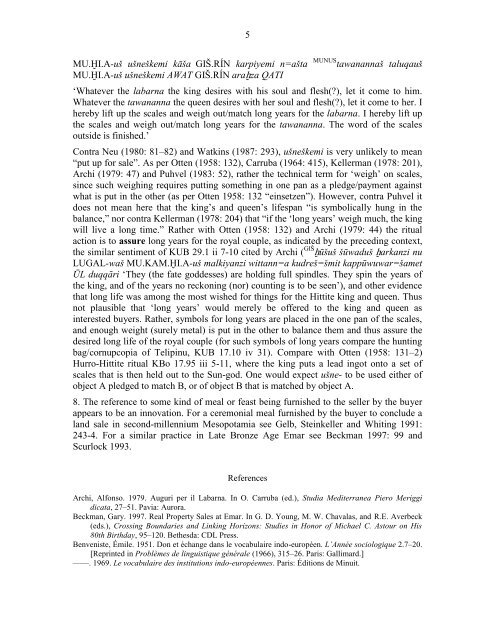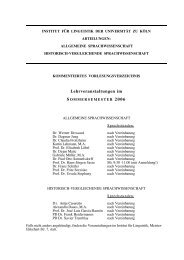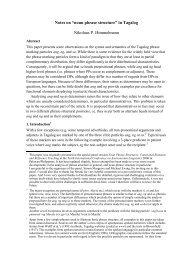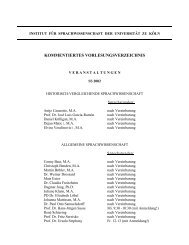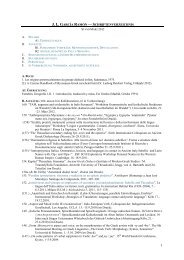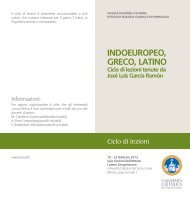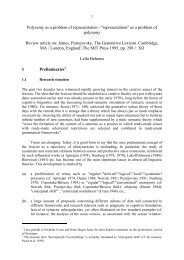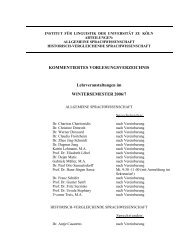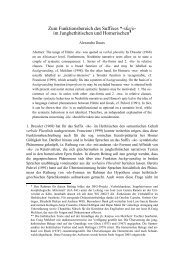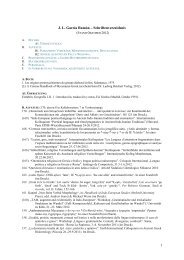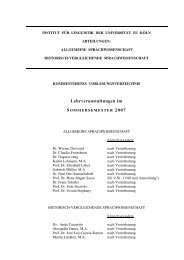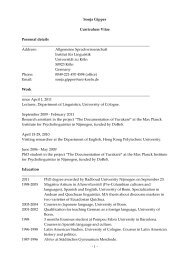Topics in Anatolian Historical Grammar Prof. Dr. H. Craig Melchert
Topics in Anatolian Historical Grammar Prof. Dr. H. Craig Melchert
Topics in Anatolian Historical Grammar Prof. Dr. H. Craig Melchert
You also want an ePaper? Increase the reach of your titles
YUMPU automatically turns print PDFs into web optimized ePapers that Google loves.
5<br />
MU.ḪI.A-uš ušneškemi kāša GIŠ.RÍN karpiyemi n=ašta MUNUS tawanannaš taluqauš<br />
MU.ḪI.A-uš ušneškemi AWAT GIŠ.RÍN araḫza QATI<br />
‘Whatever the labarna the k<strong>in</strong>g desires with his soul and flesh(?), let it come to him.<br />
Whatever the tawananna the queen desires with her soul and flesh(?), let it come to her. I<br />
hereby lift up the scales and weigh out/match long years for the labarna. I hereby lift up<br />
the scales and weigh out/match long years for the tawananna. The word of the scales<br />
outside is f<strong>in</strong>ished.’<br />
Contra Neu (1980: 81–82) and Watk<strong>in</strong>s (1987: 293), ušneškemi is very unlikely to mean<br />
“put up for sale”. As per Otten (1958: 132), Carruba (1964: 415), Kellerman (1978: 201),<br />
Archi (1979: 47) and Puhvel (1983: 52), rather the technical term for ‘weigh’ on scales,<br />
s<strong>in</strong>ce such weigh<strong>in</strong>g requires putt<strong>in</strong>g someth<strong>in</strong>g <strong>in</strong> one pan as a pledge/payment aga<strong>in</strong>st<br />
what is put <strong>in</strong> the other (as per Otten 1958: 132 “e<strong>in</strong>setzen”). However, contra Puhvel it<br />
does not mean here that the k<strong>in</strong>g’s and queen’s lifespan “is symbolically hung <strong>in</strong> the<br />
balance,” nor contra Kellerman (1978: 204) that “if the ‘long years’ weigh much, the k<strong>in</strong>g<br />
will live a long time.” Rather with Otten (1958: 132) and Archi (1979: 44) the ritual<br />
action is to assure long years for the royal couple, as <strong>in</strong>dicated by the preced<strong>in</strong>g context,<br />
the similar sentiment of KUB 29.1 ii 7-10 cited by Archi ( GIŠ ḫūšuš šūwaduš ḫarkanzi nu<br />
LUGAL-waš MU.KAM.ḪI.A-uš malkiyanzi wittann=a kudreš=šmit kappūwuwar=šamet<br />
ŪL duqqāri ‘They (the fate goddesses) are hold<strong>in</strong>g full sp<strong>in</strong>dles. They sp<strong>in</strong> the years of<br />
the k<strong>in</strong>g, and of the years no reckon<strong>in</strong>g (nor) count<strong>in</strong>g is to be seen’), and other evidence<br />
that long life was among the most wished for th<strong>in</strong>gs for the Hittite k<strong>in</strong>g and queen. Thus<br />
not plausible that ‘long years’ would merely be offered to the k<strong>in</strong>g and queen as<br />
<strong>in</strong>terested buyers. Rather, symbols for long years are placed <strong>in</strong> the one pan of the scales,<br />
and enough weight (surely metal) is put <strong>in</strong> the other to balance them and thus assure the<br />
desired long life of the royal couple (for such symbols of long years compare the hunt<strong>in</strong>g<br />
bag/cornupcopia of Telip<strong>in</strong>u, KUB 17.10 iv 31). Compare with Otten (1958: 131–2)<br />
Hurro-Hittite ritual KBo 17.95 iii 5-11, where the k<strong>in</strong>g puts a lead <strong>in</strong>got onto a set of<br />
scales that is then held out to the Sun-god. One would expect ušne- to be used either of<br />
object A pledged to match B, or of object B that is matched by object A.<br />
8. The reference to some k<strong>in</strong>d of meal or feast be<strong>in</strong>g furnished to the seller by the buyer<br />
appears to be an <strong>in</strong>novation. For a ceremonial meal furnished by the buyer to conclude a<br />
land sale <strong>in</strong> second-millennium Mesopotamia see Gelb, Ste<strong>in</strong>keller and Whit<strong>in</strong>g 1991:<br />
243-4. For a similar practice <strong>in</strong> Late Bronze Age Emar see Beckman 1997: 99 and<br />
Scurlock 1993.<br />
References<br />
Archi, Alfonso. 1979. Auguri per il Labarna. In O. Carruba (ed.), Studia Mediterranea Piero Meriggi<br />
dicata, 27–51. Pavia: Aurora.<br />
Beckman, Gary. 1997. Real Property Sales at Emar. In G. D. Young, M. W. Chavalas, and R.E. Averbeck<br />
(eds.), Cross<strong>in</strong>g Boundaries and L<strong>in</strong>k<strong>in</strong>g Horizons: Studies <strong>in</strong> Honor of Michael C. Astour on His<br />
80th Birthday, 95–120. Bethesda: CDL Press.<br />
Benveniste, Émile. 1951. Don et échange dans le vocabulaire <strong>in</strong>do-européen. L’Année sociologique 2.7–20.<br />
[Repr<strong>in</strong>ted <strong>in</strong> Problèmes de l<strong>in</strong>guistique générale (1966), 315–26. Paris: Gallimard.]<br />
——. 1969. Le vocabulaire des <strong>in</strong>stitutions <strong>in</strong>do-européennes. Paris: Éditions de M<strong>in</strong>uit.


